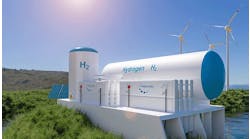This means that industrial displays must be designed to prevent the possibility of ignition dangers in a hazardous environment. This is done by building products that are intrinsically safe; that is, their storage and energy consumption comply with regulated standards for safe level limits according to specified fault conditions. In the case of industrial flat-panel displays, it is important to realize that they consume electrical energy and will be connected to an external power source, which means that sparks or arcing from short circuits or other failures can still occur and cause an explosive atmosphere to ignite.
Standards of Intrinsic Safety
One solution is for electronics in hazardous areas to be sealed within a gastight, positively pressurized enclosure to isolate sources of electrical discharge from the atmosphere. However, an intrinsically safe solution is more secure, and to acquire this certification, equipment must be tested and approved by an independent agency. Approval is granted according to the level of energy allowed to be stored or transferred within the display equipment. For intrinsic safety certification to be granted, equipment must be unable to generate sufficient thermal or electrical energy to result in an explosion in the atmosphere.
Intrinsic safety is not only based on its performance, but also on any signal I/O feeds or external power. These need to reach the equipment from a safety barrier situated in a safe location, which usually include a series of resistors, diodes and fuses that are appropriately sized and arranged to limit the level of energy supplied to the equipment. However, no piece of equipment is intrinsically safe in all conditions. This is because its geographical location, how it is connected and the class of hazardous environment also play important roles.
Other safety considerations for electronic equipment destined for hazardous areas include the control of component temperatures, while competent spacing must be such that it prevents dust from causing short circuits. Safeguards, including current limiting by fuses and resistors, must be implemented to make sure none of the components reach temperatures that can cause auto-ignition of an explosive atmosphere. As components and their PCBs become higher in power density and more compact, these issues become increasingly important.
Safety of Industrial Displays
The intrinsic safety of industrial displays and other relevant equipment remains an important area for ensuring safety standards. Equipment must always be independently tested and approved, and be appropriate for the atmosphere of the environment in which it is situated. This includes environments where there is the presence of ignitable fibers, gases, vapors or flammable liquids. This is a technology that continues to evolve and so do measures to ensure safety standards.



